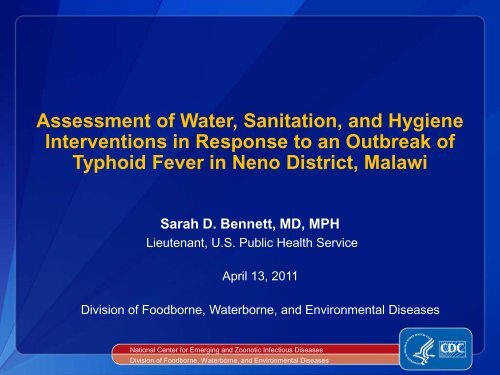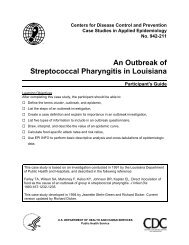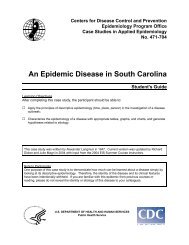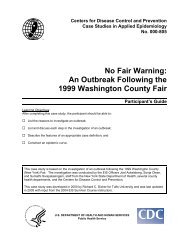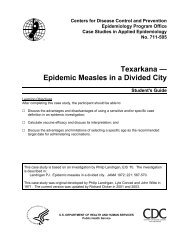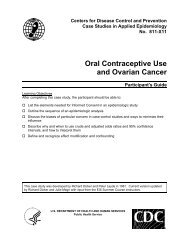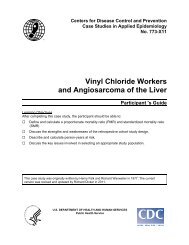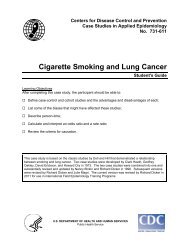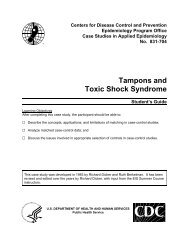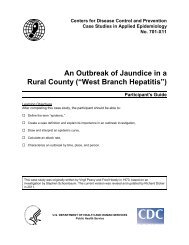Typhoid Fever - Library
Typhoid Fever - Library
Typhoid Fever - Library
You also want an ePaper? Increase the reach of your titles
YUMPU automatically turns print PDFs into web optimized ePapers that Google loves.
Assessment of Water, Sanitation, and Hygiene<br />
Interventions in Response to an Outbreak of<br />
<strong>Typhoid</strong> <strong>Fever</strong> in Neno District, Malawi<br />
Sarah D. Bennett, MD, MPH<br />
Lieutenant, U.S. Public Health Service<br />
April 13, 2011<br />
Division of Foodborne, Waterborne, and Environmental Diseases<br />
National Center for Emerging and Zoonotic Infectious Diseases<br />
Division of Foodborne, Waterborne, and Environmental Diseases
<strong>Typhoid</strong> <strong>Fever</strong><br />
Salmonella enterica serovar Typhi<br />
21 million illnesses and 200,000<br />
deaths<br />
Humans are the only known<br />
reservoir<br />
Infection through contact with<br />
contaminated food or water
Outbreak Timeline<br />
Onset<br />
Neno District<br />
Malawi<br />
Tsangano District<br />
Mozambique<br />
May<br />
2009<br />
Aug Oct April June Aug Sept
Outbreak Timeline<br />
Onset<br />
Multinational investigation<br />
May June Aug Oct Dec Feb April<br />
2009<br />
2010<br />
June Aug Sept<br />
302 cases
Outbreak Timeline<br />
Onset<br />
Multinational investigation<br />
May June Aug Oct Dec Feb April<br />
2009<br />
2010<br />
June Aug Sept<br />
Prevention interventions
Outbreak Timeline<br />
Multinational investigation<br />
Onset<br />
Rainy season<br />
May June Aug Oct Dec Feb April<br />
2009<br />
2010<br />
June Aug Sept<br />
Prevention interventions
Interventions<br />
Community meetings or “<strong>Typhoid</strong> Talks”<br />
• Cause, treatment and prevention of typhoid fever<br />
• Household stored water treatment<br />
Distribution of WaterGuard<br />
• Locally produced<br />
• Dilute sodium hypochlorite solution<br />
Infrastructural improvements<br />
• Boreholes<br />
• Pit latrines
Outbreak Timeline<br />
Multinational investigation<br />
Onset<br />
Rainy season<br />
784 cases<br />
44 deaths<br />
May June Aug Oct Dec Feb April<br />
2009<br />
2010<br />
June Aug Sept<br />
Prevention interventions
Outbreak Timeline<br />
Multinational investigation<br />
Onset<br />
Rainy season<br />
WASH Survey<br />
May June Aug Oct Dec Feb April<br />
2009<br />
2010<br />
June Aug Sept<br />
Prevention interventions
Impact of prevention<br />
interventions on<br />
WASH Survey Objectives<br />
• Knowledge of cause and<br />
prevention of typhoid fever<br />
• Knowledge, attitudes and<br />
practices regarding safe water<br />
• Receipt and use of WaterGuard
17 villages<br />
Methods: WASH Survey<br />
• Neno District, Malawi<br />
• Reported cases in 2009 and 2010<br />
10-12 female heads of<br />
household per village<br />
• Randomly selected
Methods: Household Stored Water Testing<br />
Free residual chlorine testing
Response Rate<br />
393 households visited<br />
202 households enrolled
Response Rate<br />
393 households visited<br />
187 unavailable<br />
4 refused<br />
202 households enrolled
Demographics<br />
All Respondents<br />
(n=202)<br />
Mean age (range) 35 (18-83)<br />
Mean persons per household (range) 5 (1-12)<br />
No education 25%<br />
Self-reported literacy 57%
Attendance at a “<strong>Typhoid</strong> Talk”<br />
56% reported attending a<br />
“<strong>Typhoid</strong> Talk”<br />
Talks led by<br />
• Community Health Workers<br />
• Clinicians<br />
• NGO’s
Reported Causes of <strong>Typhoid</strong> <strong>Fever</strong><br />
Total<br />
(n=202)<br />
Poor hygiene 73%<br />
Drinking bad water 47%<br />
Eating bad food 27%
Reported Causes of <strong>Typhoid</strong> <strong>Fever</strong><br />
<strong>Typhoid</strong> Talk<br />
(n=111)<br />
No <strong>Typhoid</strong> Talk<br />
(n=87)<br />
p-value<br />
Poor hygiene 85% 64% < 0.01<br />
Drinking bad water 55% 42% 0.02<br />
Eating bad food 34% 21% 0.13
Reported Methods of Prevention<br />
Total<br />
(n=202)<br />
Treat water 65%<br />
Wash hands 50%<br />
Clean cooking utensils /<br />
vessels<br />
36%<br />
Cook food thoroughly 34%
Reported Methods of Prevention<br />
<strong>Typhoid</strong> Talk<br />
(n=111)<br />
No <strong>Typhoid</strong> Talk<br />
(n=87)<br />
p-value<br />
Treat water 70% 63% 0.30<br />
Hand washing 52% 51% 0.89<br />
Clean cooking utensils /<br />
vessels<br />
44% 26% 0.04<br />
Cook food thoroughly 32% 38% 0.55
Impact of “<strong>Typhoid</strong> Talks” on Knowledge of Cause<br />
and Prevention of <strong>Typhoid</strong> <strong>Fever</strong><br />
Household understanding of causes and methods of<br />
preventing typhoid fever are low<br />
Attendance at a “<strong>Typhoid</strong> Talk”<br />
• Improved knowledge of hygiene and water as causes<br />
• Did not improve knowledge of food as a potential cause<br />
• Did not significantly improve knowledge of prevention methods
Sources of Household Water<br />
4% Rivers<br />
48% Boreholes 46% Unprotected<br />
wells<br />
2% Public Taps
Additional Sources of Household Water<br />
57% Unprotected wells<br />
6% Rivers<br />
Primary borehole users<br />
3% Another borehole
Treatment of Household Stored Water<br />
70% reported treating water in preceding 2 weeks<br />
Most common reasons for not treating water<br />
• Lack of WaterGuard (57%) or 1% stock chlorine solution (40%)<br />
• Current water is safe (18%)<br />
• Too busy (12%)<br />
• Bad taste or smell associated with treatment (2%)
Methods of Treating Household Stored Water<br />
100% 98%<br />
2009<br />
89%<br />
2010<br />
79%<br />
80%<br />
Reported Frequency<br />
60%<br />
40%<br />
20%<br />
47% 48%<br />
23%<br />
36%<br />
16%<br />
0%<br />
Any chlorine product WaterGuard 1% stock chlorine solution Boiling
WaterGuard in the Home<br />
84% received free WaterGuard<br />
53% had WaterGuard observed in<br />
the home<br />
• 33% used to treat currently stored water
Free Residual Chlorine Testing<br />
Adequate Free<br />
Residual Chlorine*<br />
All households with stored water<br />
15% (n=152)<br />
Households who reported treating<br />
water with WaterGuard<br />
63% (n=38)<br />
*Adequate free residual chlorine defined as ≥ 0.2 milligrams per liter
Impact of Interventions on Knowledge, Attitudes and<br />
Practices of Safe Water<br />
Most households use unimproved sources of water<br />
WaterGuard was distributed<br />
• Few used it to treat stored water<br />
• Supply insufficient to treat all stored water<br />
Adequate chlorine levels in few households<br />
Most households do not have safe drinking water
Limitations of WASH Survey<br />
Lack of a baseline evaluation for comparison<br />
Challenges in typhoid fever surveillance<br />
Ongoing prevention activities during survey<br />
High rate of unavailable target respondents
Conclusions<br />
Knowledge of relationship between unsafe water,<br />
food and typhoid fever remains low<br />
“<strong>Typhoid</strong> Talks” improved knowledge of poor<br />
hygiene and unsafe water as causes<br />
• Did not improve knowledge of food as cause<br />
• Did not improve knowledge of prevention methods<br />
WaterGuard was distributed, but use is low<br />
Many households remain without safe drinking water
Recommendations<br />
Improve attendance and effectiveness of educational<br />
campaigns or “<strong>Typhoid</strong> Talks”<br />
• Increase knowledge of typhoid fever<br />
• Emphasize importance of household stored water treatment<br />
Improve delivery and promote use of WaterGuard<br />
• Sustainable access to WaterGuard at household level<br />
Continue improvement of water and sanitation<br />
infrastructure in Neno District
Acknowledgements<br />
WHO<br />
Ministry of Health, Malawi<br />
Neno District Health Office<br />
UNICEF<br />
Partners in Health<br />
USAID<br />
PSI<br />
Action Aid<br />
All the staff, enumerators and<br />
drivers who participated in planning,<br />
logistics and data collection<br />
<br />
CDC<br />
• Lauren Blum<br />
• Cheryl Bopp<br />
• Linda Capewell<br />
• Austin Demby<br />
• Holly Dentz<br />
• Leonard Floyd<br />
• Mike Humphreys<br />
• Sara Lowther<br />
• Eric Mintz<br />
• Benjamin Nygren<br />
• Michele Parsons<br />
• Jim Sejvar<br />
• Ethel Taylor<br />
• Tom Warne
Thank you!<br />
For more information please contact Centers for Disease Control and<br />
Prevention<br />
1600 Clifton Road NE, Atlanta, GA 30333<br />
Telephone, 1-800-CDC-INFO (232-4636)/TTY: 1-888-232-6348<br />
E-mail: cdcinfo@cdc.gov Web: www.cdc.gov<br />
The findings and conclusions in this report are those of the authors and do not necessarily represent the official<br />
position of the Centers for Disease Control and Prevention.<br />
National Center for Emerging and Zoonotic Infectious Diseases<br />
Division of Foodborne, Waterborne and Environmental Diseases
ADDITIONAL SLIDES
Outbreak Timeline<br />
Multinational investigation<br />
Onset<br />
Rainy season<br />
WASH Survey<br />
784 cases<br />
44 deaths<br />
May June Aug Oct Dec Feb April<br />
2009<br />
2010<br />
302 cases<br />
June Aug Sept<br />
Prevention interventions
Epidemic Curve for <strong>Typhoid</strong> <strong>Fever</strong> Outbreak<br />
Number of Cases<br />
100<br />
90<br />
80<br />
70<br />
60<br />
50<br />
40<br />
30<br />
20<br />
10<br />
0<br />
Active Surveillance<br />
(Outbreak investigation)<br />
Mar Apr May June July Aug Sept Oct Nov Dec Jan Feb Mar Apr May June July Aug Sept<br />
2009 2010<br />
Passive Surveillance<br />
Laboratory<br />
Capacity<br />
Building<br />
Month and Year Suspected Probable Confirmed
Early Intervention<br />
Late Intervention<br />
Nsambe<br />
Clinic<br />
Neno District<br />
Hospital
Attendance at a “<strong>Typhoid</strong> Talk” by Village<br />
Village<br />
Targeted<br />
Education<br />
"<strong>Typhoid</strong> Talk"<br />
Attendance<br />
Chakulembera Yes 64%<br />
Chikalema No 36%<br />
Chimbalanga I Yes 36%<br />
Chimbalanga II Yes 33%<br />
Chiyembekeza Yes 82%<br />
Kagudza Yes 58%<br />
Kaingilira Yes 58%<br />
Kalimedzako Yes 33%<br />
Kamoto No 33%<br />
Kumbwani Yes 33%<br />
Kundembo Yes 45%<br />
Kweneza Yes 92%<br />
Masamba Yes 67%<br />
Moffat Yes 67%<br />
Mposadala Yes 67%<br />
Mtemankhawa Yes 83%<br />
Nseula Yes 64%
Results: Products Received at “<strong>Typhoid</strong> Talk”<br />
100%<br />
80%<br />
84%<br />
78%<br />
Reported Frequency<br />
60%<br />
40%<br />
30%<br />
20%<br />
14%<br />
11%<br />
5%<br />
0%<br />
WaterGuard Soap Advice or<br />
information<br />
1% stock<br />
chlorine<br />
solution<br />
Print materials<br />
T-shirt
Reported Causes of <strong>Typhoid</strong> <strong>Fever</strong><br />
Total<br />
(n=202)<br />
<strong>Typhoid</strong> Talk<br />
(n=111)<br />
No <strong>Typhoid</strong> Talk<br />
(n=87)<br />
p-value<br />
Poor hygiene 73% 85% 64% < 0.01<br />
Drinking bad water 47% 55% 42% 0.02<br />
Eating bad food 27% 34% 21% 0.13<br />
Flies 7% 11% 3% 0.06<br />
Unwashed fruits / vegetables 7% 6% 9% 0.24<br />
Don't know 14% 5% 20% 0.01
Reported Methods of Prevention<br />
Total<br />
(n=202)<br />
<strong>Typhoid</strong> Talk<br />
(n=111)<br />
No <strong>Typhoid</strong> Talk<br />
(n=87)<br />
p-value<br />
Treat water 65% 70% 63% 0.30<br />
Hand washing 50% 52% 51% 0.89<br />
Clean cooking utensils /<br />
vessels<br />
36% 44% 26% 0.04<br />
Cook food thoroughly 34% 32% 38% 0.55<br />
Wash fruits / vegetables 18% 13% 25% 0.14<br />
Don’t know 7% 1% 10% 0.01
96% would go to a<br />
health facility<br />
Treatment of <strong>Typhoid</strong> <strong>Fever</strong><br />
3% reported a home<br />
remedy<br />
Traditional healers were<br />
not mentioned by any<br />
respondent
Diseases Caused by Drinking Unsafe Water<br />
Reported Frequency<br />
100%<br />
80%<br />
60%<br />
40%<br />
20%<br />
0%<br />
89%<br />
37%<br />
44% attending a “<strong>Typhoid</strong> Talk” compared<br />
to 31% not attending a talk (p = 0.04)<br />
33%<br />
21%<br />
18%<br />
11%<br />
Diarrhea <strong>Typhoid</strong> Cholera Malaria <strong>Fever</strong> Dysentery Don't know<br />
2%
Storage of Household Water<br />
74% wide-mouthed vessels<br />
• 57% covered<br />
• 99% scoop with ladle / cup<br />
27% narrow-mouthed vessels<br />
• 99% pour water
Uses of Household Stored Water<br />
100%<br />
92%<br />
80%<br />
Reported Frequency<br />
60%<br />
40%<br />
66%<br />
57%<br />
39%<br />
30%<br />
20%<br />
0%<br />
Cooking<br />
Washing cooking<br />
utensils / vessels<br />
Bathing Washing fruits /<br />
vegetables<br />
Washing clothes
Markers of Water Safety<br />
100%<br />
80%<br />
Reported Frequency<br />
60%<br />
40%<br />
20%<br />
0%<br />
54%<br />
Appearance<br />
28%<br />
It is<br />
protected<br />
35% reported clear water can make them sick<br />
19%<br />
16%<br />
11%<br />
Smell Taste Containers<br />
are clean /<br />
covered<br />
2%<br />
People get<br />
sick<br />
19%<br />
Don't know
Reasons for Treating Household Stored Water<br />
Overall<br />
<strong>Typhoid</strong> Talk<br />
(n=111)<br />
No <strong>Typhoid</strong> Talk<br />
(n=87)<br />
p-value<br />
Makes water safer 83.4% 81.0% 88.0% 0.10<br />
CHW visited village to talk about it 19.4% 26.3% 11.9% 0.04<br />
Received water treatment for free 7.3% 11.0% 3.4% 0.01<br />
Someone at health facility said important 3.8% 3.3% 2.3% 0.54<br />
Family / friends said important 1.2% 0.0% 2.6% Undefined
Receipt and Observed WaterGuard by Village<br />
Village<br />
WaterGuard<br />
Distribution<br />
Reported Receipt of<br />
WaterGuard<br />
Observed WaterGuard<br />
in Home<br />
Chakulembera Yes 100% 27%<br />
Chikalema No 25% 0%<br />
Chimbalanga I Yes 92% 50%<br />
Chimbalanga II Yes 100% 92%<br />
Chiyembekeza Yes 100% 50%<br />
Kagudza Yes 100% 100%<br />
Kaingilira Yes 100% 50%<br />
Kalimedzako Yes 100% 92%<br />
Kamoto No 0% 0%<br />
Kumbwani Yes 100% 73%<br />
Kundembo Yes 100% 83%<br />
Kweneza Yes 100% 58%<br />
Masamba Yes 100% 58%<br />
Moffat Yes 100% 50%<br />
Mposadala Yes 100% 58%<br />
Mtemankhawa Yes 100% 33%<br />
Nseula Yes 100% 80%
Receipt and Observed WaterGuard by Village<br />
Village<br />
WaterGuard<br />
Distribution<br />
Reported Receipt of<br />
WaterGuard<br />
Observed WaterGuard<br />
in Home<br />
Chakulembera Yes 100% 27%<br />
Chikalema No 25% 0%<br />
Chimbalanga I Yes 92% 50%<br />
Chimbalanga II Yes 100% 92%<br />
Chiyembekeza Yes 100% 50%<br />
Kagudza Yes 100% 100%<br />
Kaingilira Yes 100% 50%<br />
Kalimedzako Yes 100% 92%<br />
Kamoto No 0% 0%<br />
Kumbwani Yes 100% 73%<br />
Kundembo Yes 100% 83%<br />
Kweneza Yes 100% 58%<br />
Masamba Yes 100% 58%<br />
Moffat Yes 100% 50%<br />
Mposadala Yes 100% 58%<br />
Mtemankhawa Yes 100% 33%<br />
Nseula Yes 100% 80%
Geographic Receipt of WaterGuard<br />
Total<br />
(n=202)<br />
Early<br />
Intervention<br />
(n=106)<br />
Late<br />
Intervention<br />
(n=96)<br />
p-value<br />
Received free WaterGuard 84% 100% 74% undefined<br />
Observed WaterGuard 53% 53% 54% 0.99
Number of Times Received Free WaterGuard<br />
100%<br />
80%<br />
Reported Frequency<br />
60%<br />
40%<br />
20%<br />
11%<br />
6%<br />
12%<br />
21% 23%<br />
12%<br />
15%<br />
0%<br />
Never Once 2 Times 3 Times 4 Times 5 Times > 5 Times
Methods of Treating Household Stored Water<br />
Overall<br />
<strong>Typhoid</strong> Talk<br />
(n=111)<br />
No <strong>Typhoid</strong> Talk<br />
(n=87)<br />
p-value<br />
WaterGuard 89.3% 94.5% 83.7% < 0.01<br />
1% Stock chlorine solution 23.0% 22.3% 24.1% 0.82<br />
Boiling 16.0% 15.8% 17.4% 0.81
Free Residual Chlorine Testing<br />
Adequate Free<br />
Residual Chlorine*<br />
All households with stored water 15%<br />
Households who reported treating water 59%<br />
Households who reported treating water with<br />
WaterGuard<br />
63%<br />
*Adequate free residual chlorine defined as ≥ 0.2 milligrams per liter
Free Residual Chlorine Testing<br />
Adequate Free Residual Chlorine<br />
Overall<br />
<strong>Typhoid</strong><br />
Talk<br />
No <strong>Typhoid</strong><br />
Talk<br />
p-value<br />
All households with stored water 15% 20% 11% 0.11<br />
Households who reported treating<br />
water<br />
59% 64% 49% 0.53<br />
Households who reported treating<br />
water with WaterGuard<br />
63% 72% 49% 0.33
100%<br />
92%<br />
Hand Hygiene<br />
When should you wash your hands<br />
80%<br />
74%<br />
Reported Frequency<br />
60%<br />
40%<br />
50%<br />
38%<br />
20%<br />
13%<br />
0%<br />
After using toilet Before eating After cleaning<br />
babies<br />
Before cooking All 4<br />
recommended
When to Wash Hands<br />
Overall<br />
(n=202)<br />
<strong>Typhoid</strong> Talk<br />
(n=11)<br />
No <strong>Typhoid</strong> Talk<br />
(n=87)<br />
p-value<br />
After using toilet 92% 94% 91% 0.42<br />
Before eating 74% 83% 64% 0.01<br />
After cleaning babies 50% 53% 48% 0.64<br />
Before cooking 38% 41% 37% 0.56<br />
All 4 guidelines 13% 12% 14% 0.71
Hand Washing Stations<br />
WATER<br />
SOAP<br />
77% reported soap in<br />
the home<br />
46% use soap for hand<br />
washing<br />
Only 1 / 202 households<br />
with a functional hand<br />
washing station
Reported Latrine Use<br />
100%<br />
80%<br />
Reported Frequency<br />
60%<br />
40%<br />
51%<br />
43%<br />
20%<br />
0%<br />
9%<br />
Own latrine Shared latrine Open defecation
Latrine Use by Intervention Village<br />
Total<br />
(n=202)<br />
Early<br />
Intervention<br />
(n=106)<br />
Late<br />
Intervention<br />
(n=96)<br />
p-value<br />
Own latrine 51% 71% 38% < 0.01<br />
Shared latrine 43% 29% 51% 0.04<br />
Open defecation 9% 2% 12% 0.01
Bacterial coliform and E.coli testing<br />
PAIRED SAMPLES<br />
5 out of 9 boreholes and all 3 public taps were<br />
positive for bacterial coliforms and E. coli
Malawi-Mozambique Border<br />
MALAWI<br />
MOZAMBIQUE<br />
KWENEZA VILLAGE<br />
NSAMBE CLINIC<br />
DACKSON CLINIC
Low refusal rate<br />
Strengths of WASH Survey<br />
Inclusion of all 17 villages affected by 2009-2010<br />
outbreak<br />
Observation of reported household practices<br />
Residual chlorine testing to confirm WaterGuard use
DELETED SLIDES
Background: Outbreak of mystery illness<br />
June 24, 2009: Neno District Health Officer reports<br />
cases of mystery illness to Malawi Ministry of Health<br />
• Cases begin on May 2, 2009<br />
• Rapid spread throughout Neno District, Malawi and neighboring<br />
Tsangano District, Mozambique<br />
• High rate of neurologic complications<br />
• Multinational investigation → Salmonella enterica serovar Typhi<br />
(<strong>Typhoid</strong> <strong>Fever</strong>)<br />
September 2010: 784 cases and 44 deaths<br />
• 2 countries, 3 districts, 8 health facilities, and 47 villages<br />
• Case-fatality ratio 5.6%
Background: Response to the outbreak<br />
July 2009 – August 2010<br />
• Community education on <strong>Typhoid</strong> <strong>Fever</strong> and household safe<br />
water, sanitation and hygiene practices<br />
• Distribution and education on use of WaterGuard for in-home<br />
stored water treatment<br />
• Construction of boreholes and protected spring boxes in the<br />
most affected villages<br />
• Construction of latrines<br />
• School-based education on hand washing and hygiene<br />
Interventions interrupted by the rainy season<br />
(November 2009 – February 2010)<br />
• Most villages inaccessible
Demographics<br />
All Respondents (n=202)<br />
Mean age (range) 35 (18-83)<br />
Mean number persons per household (range) 5.14 (1-12)<br />
No education 25%<br />
Some primary education 70%<br />
Self-reported literacy 57%
Results: Reported Source of “<strong>Typhoid</strong> Talks”<br />
100%<br />
(n=111)<br />
80%<br />
Reporting Frequency<br />
60%<br />
40%<br />
20%<br />
63%<br />
27%<br />
16%<br />
0%<br />
Community<br />
Health<br />
Workers<br />
Clinicians NGO's (PSI /<br />
Unicef)<br />
8% 5% 4% 2%<br />
Neighbors /<br />
Family /<br />
Friends<br />
Drama<br />
Performance<br />
Movie<br />
Radio
Results: Reported Causes of <strong>Typhoid</strong> <strong>Fever</strong><br />
100%<br />
(n=202)<br />
Reporting Frequency<br />
80%<br />
60%<br />
40%<br />
73%<br />
47%<br />
27%<br />
20%<br />
7% 7%<br />
14%<br />
0%<br />
Poor hygiene<br />
Drinking bad<br />
water<br />
Eating bad<br />
food<br />
Flies<br />
Unwashed<br />
fruits /<br />
vegetables<br />
Don't know
Results: Reported Methods for Preventing<br />
<strong>Typhoid</strong> <strong>Fever</strong><br />
100%<br />
(n=202)<br />
80%<br />
Reporting Frequency<br />
60%<br />
40%<br />
20%<br />
0%<br />
2%<br />
No<br />
prevention<br />
available<br />
65%<br />
Treat water<br />
50%<br />
Hand<br />
washing<br />
36% 34%<br />
Clean<br />
cooking<br />
utensils /<br />
vessels<br />
Cook food<br />
thoroughly<br />
18%<br />
Wash fruits /<br />
vegetables<br />
7%<br />
Don't know
Results: Primary Source of Household Water<br />
100%<br />
(n=202)<br />
80%<br />
Reported Frequency<br />
60%<br />
40%<br />
20%<br />
48% 46%<br />
0%<br />
4% 2%<br />
Borehole Unprotected well River Public tap
Results: Additional Sources of Household Water<br />
100%<br />
Among Primary Borehole Users (n=84)<br />
80%<br />
Reported Frequency<br />
60%<br />
40%<br />
57%<br />
20%<br />
0%<br />
6%<br />
3%<br />
Unprotected well River Another borehole
Results: Access to Household Stored Water<br />
100%<br />
(n=202)<br />
80%<br />
74%<br />
Reported Frequency<br />
60%<br />
40%<br />
20%<br />
27%<br />
0%<br />
Use a scoop<br />
Pour water


